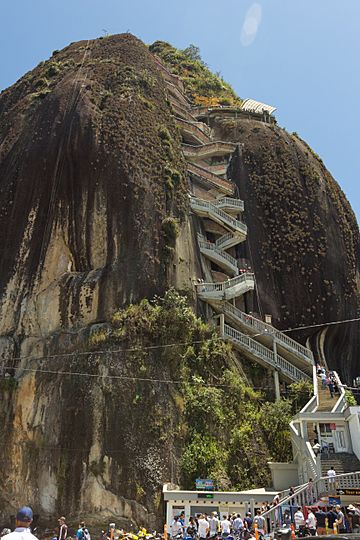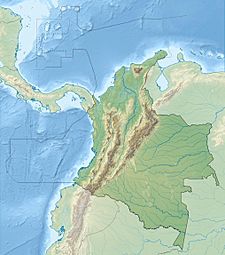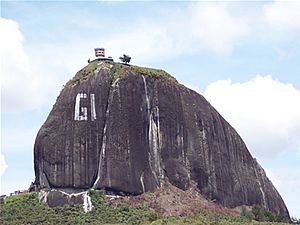El Peñón de Guatapé facts for kids
Quick facts for kids El Peñól de Guatapé |
|
|---|---|

The Rock of Guatapé.
|
|
| Highest point | |
| Elevation | 2,137 m (7,011 ft) |
| Geography | |
| Country | Colombia |
| State | Antioquia |
| Parent range | Central Ranges, Andes |
| Geology | |
| Mountain type | Granite dome |
| Climbing | |
| First ascent | Prehistoric |
The Rock of Guatapé is a famous natural landmark in Colombia. It is also known as The Stone of El Peñol or simply La Piedra. This giant rock stands tall in the Antioquia region, near the towns of Guatapé and El Peñol. Both towns have historically claimed the rock, leading to its different names.
The rock is a type of landform called an inselberg. This means it's a lonely mountain or hill that stands out from the flatter land around it. It is made of very strong granite rock. This granite has resisted wearing away and breaking down over millions of years. The Rock of Guatapé rises about 200 meters (656 feet) from its base.
Visitors can climb to the very top of the rock. There is a long staircase with 708 steps built into one side. You need to pay a small fee to climb the steps. Near the bottom of the rock, you will find many shops and food stalls. The whole area is great for taking pictures. Local artists have painted colorful murals of the rock inside the restaurants and stores. There is even a special area where tourists can take photos with the town's name and La Piedra behind them.
At the bottom of the rock, there is a bronze statue of Luis Eduardo Villegas López. This statue honors him as the first person to officially climb to the top of the rock. About halfway up the stairs, there is a small shrine dedicated to the Virgin Mary. At the very top, you will find a three-story viewing tower, a convenience store, and a place to sit and rest. The top of the rock has a railing with special decorations called zocalos. You can even book helicopter tours nearby to fly around the rock and see it from above.
The Rock's Story
Geologists believe this amazing rock is about 65 million years old. Long ago, the native Tahamí people lived in this area. They thought the rock was sacred and called it mojarrá or mujará, which means 'rock' or 'stone' in their language.
The first official climb of the rock happened on July 16, 1954. Luis Eduardo Villegas López, Pedro Nel Ramírez, and Ramón Díaz climbed it. It took them five days, using sticks fixed to the rock's wall. Luis Eduardo Villegas López later bought the rock from local farmers. They thought the land was useless for farming. He then built the famous stairs into a crack in the rock. He started charging people to climb the steps. The Villegas family still earns money from his actions today.
A new type of plant was discovered on top of the rock by a German scientist. It was named Pitcairnia heterophylla. From the top of the rock, you can see a huge dam with a 500-kilometer shoreline. There are exactly 708 steps to the highest point of the building at the summit. Blue numbers on the steps help you keep track as you climb. In the 1940s, the Colombian government declared the rock a National Monument.
The Mystery Letters
On one side of the rock, you can see large white letters painted: a "G" and an incomplete "U". It looks like an "I". This unfinished painting tells a story about the towns of Guatapé and El Peñol. They have argued for a long time about who owns the rock. The people of Guatapé decided to paint their town's name on the rock in huge letters.
However, the people of El Peñol quickly noticed what was happening. A large group gathered to stop them. This is why the painting was never finished.
At the entrance to a place called La Plazoleta, there is a mural. It shows La Piedra floating and a spaceman with the words, "¡Nos están dejando!" This means "They are leaving us!" Locals once believed that the rock came from aliens.
Rock Facts
The Rock of Guatapé rises from the bottom of the hydroelectric dam of Peñon de Guatapé. This giant rock was used as a border marker between country farms and the two nearby cities.
At its highest point, on the back (southeast side), it is 2,135 meters (6,990 feet) above sea level. The average temperature there is about 18°C (64°F). The "Peñol" is 285 meters (935 feet) long and 110 meters (360 feet) wide. It has some natural cracks. One of these cracks was used to build the 740 steps of the stairway to the summit.
The Stone of Peñol is made up of three main minerals: quartz, feldspar, and granite.
Gallery
See also
 In Spanish: Piedra del Peñol para niños
In Spanish: Piedra del Peñol para niños
- Sugarloaf Mountain
- Penyal d'Ifac Natural Park
- List of inselbergs







